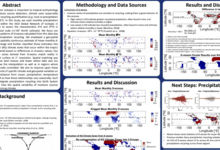The relationship of precipitation recycling to climate in the tropics through stable isotopes

The study of stable precipitation isotopes is important to tropical ecohydrology due to the potential for moisture source detection, climate zone seasonality characterization and moisture recycling quantification (e.g. local re-precipitation of water vapor derived from ET). In this study, we used monthly precipitation isotope data from 395 sites within the IAEA Global Network of Isotopes in Precipitation (GNIP) database to assess the characteristics d2H and d18O in precipitation at the pan-tropical scale (+/-30 North Latitude). We focus our efforts on investigating spatial patterns of d-excess calculated from this data due to its strong sensitivity to precipitation recycling. We employed a geospatial interpolation method to get a spatially continuous estimate of mean monthly d-excess across this latitudinal range and further classified these estimates into the three main Köppen-Geiger (KG) climate zones that occur within the tropics (e.g. tropical, temperate and arid) based on differences in d-excess values. Our results show the KG climate zones derived from D-excess match reality in greater than 60% of the land surface at 1 resolution. Spatial matching was highest over larger continental land masses and lower where data was too sparse to appropriately resolve the interpolation as well as in regions where precipitation was more seasonally controlled. We aim to improve upon these estimates by investigating the role of specific climate and geospatial variables on d-excess values that include distance from ocean, precipitation, temperature and evapotranspiration as well as how these relationships vary seasonally. Such an effort will be useful to integrate precipitation recycling into Earth System Models (ESMs) to determine how the spatial variability of moisture sources might be changing under a warming climate.
